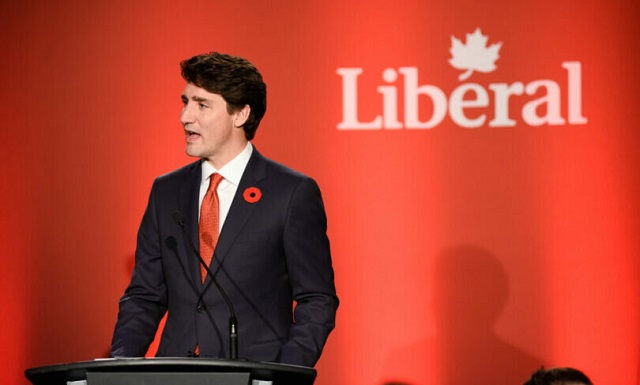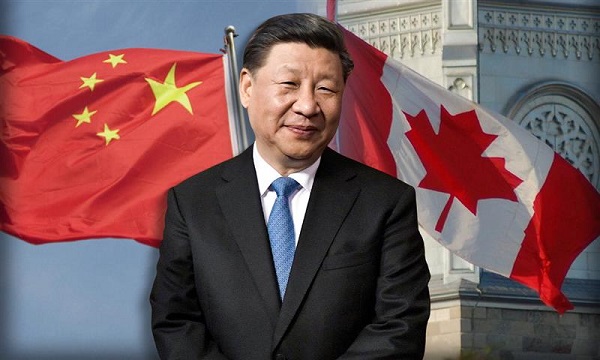Business
Trudeau gov’t fall economic statement includes massive payouts to legacy media ahead of election

From LifeSiteNews
The subsidies for legacy media come as Canadians’ trust in mainstream media is polling at an all-time low
The federal government of Prime Minister Justin Trudeau’s fall economic statement includes massive payouts for mainstream media outlets ahead of and after the 2025 election.
On November 21, Finance Minister Chrystia Freeland delivered the Liberal Government’s Fall Economic Statement in the House of Commons, which includes legacy media subsidies which will cost taxpayers $129 million over the next five years.
“To ensure a strong and independent press can continue to thrive in Canada the Fall Economic Statement proposes to enhance the Canadian journalism labour tax credit,” the Department of Finance wrote.
Beginning in 2019, Parliament changed the Income Tax Act to give yearly rebates of 25 percent for each news employee in cabinet-approved media outlets earning up to $55,000 a year, to a maximum of $13,750.
However, the Canadian Heritage Department since admitted that the payouts are not sufficient to keep legacy media outlets running. The department recommended that rebates be doubled next year to a maximum $29,750 annually.
This suggestion was adopted by the Trudeau government in the Fall Economic Statement, which increased the rebates to 35 percent on newsroom salaries up to $85,000, totaling a maximum rebate of $29,750. The temporary tax credit is set to apply for the next four years.
While media subsidies were to set to expire March 31, 2024, they have now been expanded to 2029 past the next general election. The increased payouts are expected to cost taxpayer $129 million in the next five years and an additional $10 million for every subsequent year.
The Trudeau government’s decision has been roundly condemned by Canadians on social media, many of whom are pointing to it as Trudeau’s attempt to make up for the failure of Bill C-18.
Bill C-18, the Online News Act, was projected to increase legacy media revenue by forcing Big Tech companies to pay to publish Canadian content on their platforms.
However, instead of paying the fees, Meta, the parent company of Facebook and Instagram, blocked all access to news content in Canada, while Google has promised to do the same. As a result, Canadians have been blocked from viewing legacy media outlets’ social media platforms.
“This is just a massive bailout using public dollars for the government’s blunder on Bill C-18,” Canadian academic and law professor Michael Geist wrote on X, formerly known as Twitter. “News outlets could previously claim a max of $13,750 per employee. That now increases to $29,750 or by 116%.”
Note that this is retroactive as it applies to expenditures from the start of the year. It’s a $60M gift to the news sector, to off-set the lost revenues due to its own legislation. So the industry lobbied for Bill C-18 and then lobbied for a bailout.https://t.co/XpccVcyRTy
— Michael Geist (@mgeist) November 21, 2023
“Note that this is retroactive as it applies to expenditures from the start of the year,” he added. “It’s a $60M gift to the news sector, to off-set the lost revenues due to its own legislation. So the industry lobbied for Bill C-18 and then lobbied for a bailout.”
Similarly, Canadian politician and CEO of the Western Standard Derek Fildebrandt said, “Ottawa is turning journalism into little better than supply-managed dairy farming. It is quickly becoming impossible to run a media company of any scale without taking the damned bailout money.”
They pass legislation devastating our ability to grow revenues, shrug their shoulders after we told them 100 times this is exactly what would happen, and propose to simply cut more bailout cheques. https://t.co/vMRLfE9CLC
— Derek Fildebrandt (@Dfildebrandt) November 21, 2023
Additionally, Royal Canadian Air Force Veteran Rex Glacer pointed out that thanks to the payouts, “Legacy media is now nothing but employees of the Liberal Party of Canada whose job is to help Trudeau win the next election, congratulations on your pay raises!”
Legacy media is now nothing but employees of the Liberal Party of Canada whose job is to help Trudeau win the next election, congratulations on your pay raises! https://t.co/26k925AlvI
— Rex Glacer (@rexglacer) November 22, 2023
The renewed media bailouts come as trust in mainstream media is polling at an all-time low with Canadians.
According to recent study by Canada’s Public Health Agency’s (PHA), less than a third of Canadians displayed “high trust” of the federal government, with “large media organizations” as well as celebrities getting even lower scores.
Large mainstream media outlets and “journalists” working for them scored a “high trust” rating of only 18 percent. This was followed by only 12 percent of people saying they trusted “ordinary people,” with celebrities garnering only an eight percent “trust” rating.
Business
Saskatchewan becomes first Canadian province to fully eliminate carbon tax

From LifeSiteNews
Saskatchewan has become the first Canadian province to free itself entirely of the carbon tax.
On March 27, Saskatchewan Premier Scott Moe announced the removal of the provincial industrial carbon tax beginning April 1, boosting the province’s industry and making Saskatchewan the first carbon tax free province.
Under Moe’s direction, Saskatchewan has dropped the industrial carbon tax which he says will allow Saskatchewan to thrive under a “tariff environment.”
“I would hope that all of the parties running in the federal election would agree with those objectives and allow the provinces to regulate in this area without imposing the federal backstop,” he continued.
The removal of the tax is estimated to save Saskatchewan residents up to 18 cents a liter in gas prices.
The removal of the tax will take place on April 1, the same day the consumer carbon tax will reduce to 0 percent under Prime Minister Mark Carney’s direction. Notably, Carney did not scrap the carbon tax legislation: he just reduced its current rate to zero. This means it could come back at any time.
Furthermore, while Carney has dropped the consumer carbon tax, he has previously revealed that he wishes to implement a corporation carbon tax, the effects of which many argued would trickle down to all Canadians.
The Saskatchewan Association of Rural Municipalities (SARM) celebrated Moe’s move, noting that the carbon tax was especially difficult on farmers.
“I think the carbon tax has been in place for approximately six years now coming up in April and the cost keeps going up every year,” SARM president Bill Huber said.
“It puts our farming community and our business people in rural municipalities at a competitive disadvantage, having to pay this and compete on the world stage,” he continued.
“We’ve got a carbon tax on power — and that’s going to be gone now — and propane and natural gas and we use them more and more every year, with grain drying and different things in our farming operations,” he explained.
“I know most producers that have grain drying systems have three-phase power. If they haven’t got natural gas, they have propane to fire those dryers. And that cost goes on and on at a high level, and it’s made us more noncompetitive on a world stage,” Huber decalred.
The carbon tax is wildly unpopular and blamed for the rising cost of living throughout Canada. Currently, Canadians living in provinces under the federal carbon pricing scheme pay $80 per tonne.
Automotive
Electric cars just another poor climate policy

From the Fraser Institute
The electric car is widely seen as a symbol of a simple, clean solution to climate change. In reality, it’s inefficient, reliant on massive subsidies, and leaves behind a trail of pollution and death that is seldom acknowledged.
We are constantly reminded by climate activists and politicians that electric cars are cleaner, cheaper, and better. Canada and many other countries have promised to prohibit the sale of new gas and diesel cars within a decade. But if electric cars are really so good, why would we need to ban the alternatives?
And why has Canada needed to subsidize each electric car with a minimum $5,000 from the federal government and more from provincial governments to get them bought? Many people are not sold on the idea of an electric car because they worry about having to plan out where and when to recharge. They don’t want to wait for an uncomfortable amount of time while recharging; they don’t want to pay significantly more for the electric car and then see its used-car value decline much faster. For people not privileged to own their own house, recharging is a real challenge. Surveys show that only 15 per cent of Canadians and 11 per cent of Americans want to buy an electric car.
The main environmental selling point of an electric car is that it doesn’t pollute. It is true that its engine doesn’t produce any CO₂ while driving, but it still emits carbon in other ways. Manufacturing the car generates emissions—especially producing the battery which requires a large amount of energy, mostly achieved with coal in China. So even when an electric car is being recharged with clean power in BC, over its lifetime it will emit about one-third of an equivalent gasoline car. When recharged in Alberta, it will emit almost three-quarters.
In some parts of the world, like India, so much of the power comes from coal that electric cars end up emitting more CO₂ than gasoline cars. Across the world, on average, the International Energy Agency estimates that an electric car using the global average mix of power sources over its lifetime will emit nearly half as much CO₂ as a gasoline-driven car, saving about 22 tonnes of CO₂.
But using an electric car to cut emissions is incredibly ineffective. On America’s longest-established carbon trading system, you could buy 22 tonnes of carbon emission cuts for about $660 (US$460). Yet, Ottawa is subsidizing every electric car to the tune of $5,000 or nearly ten times as much, which increases even more if provincial subsidies are included. And since about half of those electrical vehicles would have been bought anyway, it is likely that Canada has spent nearly twenty-times too much cutting CO₂ with electric cars than it could have. To put it differently, Canada could have cut twenty-times more CO₂ for the same amount of money.
Moreover, all these estimates assume that electric cars are driven as far as gasoline cars. They are not. In the US, nine-in-ten households with an electric car actually have one, two or more non-electric cars, with most including an SUV, truck or minivan. Moreover, the electric car is usually driven less than half as much as the other vehicles, which means the CO₂ emission reduction is much smaller. Subsidized electric cars are typically a ‘second’ car for rich people to show off their environmental credentials.
Electric cars are also 320–440 kilograms heavier than equivalent gasoline cars because of their enormous batteries. This means they will wear down roads faster, and cost societies more. They will also cause more air pollution by shredding more particulates from tire and road wear along with their brakes. Now, gasoline cars also pollute through combustion, but electric cars in total pollute more, both from tire and road wear and from forcing more power stations online, often the most polluting ones. The latest meta-study shows that overall electric cars are worse on particulate air pollution. Another study found that in two-thirds of US states, electric cars cause more of the most dangerous particulate air pollution than gasoline-powered cars.
These heavy electric cars are also more dangerous when involved in accidents, because heavy cars more often kill the other party. A study in Nature shows that in total, heavier electric cars will cause so many more deaths that the toll could outweigh the total climate benefits from reduced CO₂ emissions.
Many pundits suggest electric car sales will dominate gasoline cars within a few decades, but the reality is starkly different. A 2023-estimate from the Biden Administration shows that even in 2050, more than two-thirds of all cars globally will still be powered by gas or diesel.
Source: US Energy Information Administration, reference scenario, October 2023
Fossil fuel cars, vast majority is gasoline, also some diesel, all light duty vehicles, the remaining % is mostly LPG.
Electric vehicles will only take over when innovation has made them better and cheaper for real. For now, electric cars run not mostly on electricity but on bad policy and subsidies, costing hundreds of billions of dollars, blocking consumers from choosing the cars they want, and achieving virtually nothing for climate change.
-

 2025 Federal Election1 day ago
2025 Federal Election1 day agoPoilievre To Create ‘Canada First’ National Energy Corridor
-

 2025 Federal Election1 day ago
2025 Federal Election1 day agoJoe Tay Says He Contacted RCMP for Protection, Demands Carney Fire MP Over “Bounty” Remark
-

 2025 Federal Election2 days ago
2025 Federal Election2 days agoChinese Election Interference – NDP reaction to bounty on Conservative candidate
-

 Daily Caller17 hours ago
Daily Caller17 hours agoBiden Administration Was Secretly More Involved In Ukraine Than It Let On, Investigation Reveals
-

 2025 Federal Election1 day ago
2025 Federal Election1 day agoLondon-Based Human Rights Group Urges RCMP to Investigate Liberal MP for Possible Counselling of Kidnapping
-

 2025 Federal Election1 day ago
2025 Federal Election1 day agoHong Kong-Canadian Groups Demand PM Carney Drop Liberal Candidate Over “Bounty” Remark Supporting CCP Repression
-

 2025 Federal Election1 day ago
2025 Federal Election1 day agoAlcohol tax and MP pay hike tomorrow (April 1)
-

 2025 Federal Election1 day ago
2025 Federal Election1 day agoFixing Canada’s immigration system should be next government’s top priority










